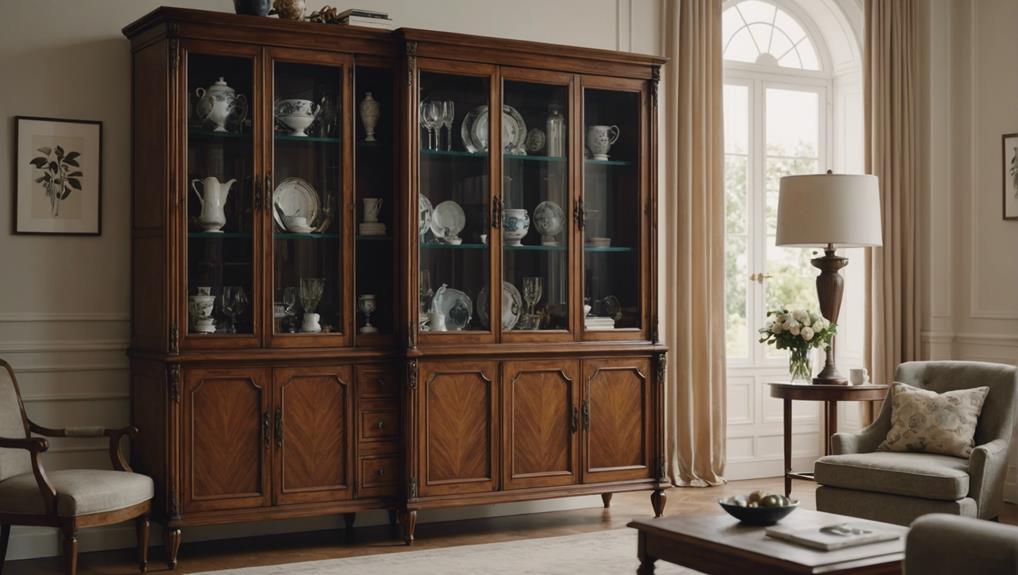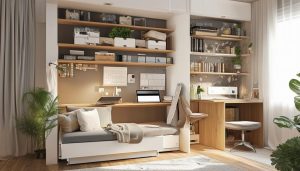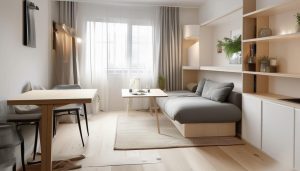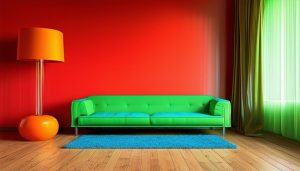Discover the realm of cabinet furniture, where craftsmanship and creativity unite to enhance your home decor.
Cabinets, essential for storage and style in spaces like kitchens and bathrooms, reflect a rich history influenced by various cultures.
Delve into materials, construction techniques, and contemporary styles to find the ideal match for your home.
Learn about cabinet maintenance, refinishing, and replacement for enduring elegance.
Gain insights into purchasing tips and professional installation guidance to master the art of cabinet furniture and elevate your living environment with both flair and functionality.
Table of Contents
ToggleDefinition of Cabinet
A cabinet is a piece of furniture designed with doors and shelves for storage or display purposes. Cabinets come in various sizes, styles, and materials, tailored to meet different needs and match diverse aesthetics.
Whether freestanding or built-in, cabinets provide functional storage and decorative elements to a room. Customizable to fit specific spaces and requirements, cabinets optimize space and enhance the visual appeal of a living area.
Used in the kitchen, bedroom, living room, or any other space, cabinets play a crucial role in storing items and elevating the ambiance of a room.
Basic explanation of what a cabinet is
A cabinet is a piece of furniture with doors and shelves for storage. It comes in various sizes, designs, and materials to cater to different needs in kitchens, bathrooms, living rooms, or offices.
Cabinets help keep spaces organized and clutter-free by concealing stored items. The key components of a cabinet include doors that swing open or slide, shelves for organizing items, and materials like wood, metal, glass, or composite materials that influence durability, appearance, and cost.
Different types of cabinets (e.g., kitchen, bathroom, file)
Cabinets are essential for storage in various spaces like kitchens, bathrooms, and offices. Kitchen cabinets store utensils, cookware, and food items for efficient meal preparation. Bathroom cabinets hold toiletries, towels, and essentials for a clutter-free environment. File cabinets in offices organize documents, papers, and files for easy access, maintaining a structured workspace.
Each type of cabinet serves a distinct function tailored to the storage needs of the specific area. Customizing cabinets optimizes space and enhances functionality and aesthetics. Understanding the purposes of kitchen, bathroom, and file cabinets helps individuals choose the right storage solution, improving organization and efficiency in living and working spaces.
History of Cabinets
Cabinets have been pivotal in storage evolution since ancient times, seen in Egyptian tombs. In the Renaissance, they became ornate pieces showcasing craftsmanship.
By the 18th and 19th centuries, cabinets featured specialized storage compartments. The 20th-century industrialization led to mass production, making cabinets more accessible.
Today, contemporary cabinet design emphasizes functionality, aesthetics, and customization for modern living spaces. Cabinets serve as both storage units and furniture reflecting cultural and technological advancements over time.
Origin anA. d evolution of cabinets
Cabinets have a long history dating back to ancient civilizations like Egypt and China. Evidence shows their use in early societies.
The Renaissance period in Europe saw notable advancements in cabinet designs and craftsmanship. Initially exclusive to the wealthy elite, cabinets became more accessible with the Industrial Revolution.
Today, modern cabinets combine functionality and aesthetics, offering a wide range of styles, materials, and customization options. They play a crucial role in enhancing and organizing living spaces.
Influence of different cultures on cabinet designs
Cabinet designs draw from diverse cultural influences, showcasing unique artistic styles, materials, and craftsmanship techniques.
Traditional Chinese cabinets feature intricate carvings, symbolic motifs, and red and gold colors symbolizing luck and prosperity.
Japanese cabinets prioritize simplicity, using natural materials like wood and space-efficient sliding doors.
Indian cabinets display vibrant colors, intricate patterns, and ornate details reflecting rich cultural heritage.
Scandinavian cabinets focus on clean lines and light wood tones inspired by natural landscapes.
Cabinet makers blend these cultural elements to create designs appealing to various tastes, enriching home decor with global influences.
Materials Used in Cabinet Making
When making cabinets, consider hardwood for durability and natural beauty. Hardwood provides longevity and aesthetic appeal.
Plywood is strong, stable, and warp-resistant. Plywood ensures strength and stability.
Particleboard is affordable but may lack longevity. Particleboard is a cost-effective option.
Laminate offers a modern look with various colors and finishes. Laminate offers sleek appearance and customization.
Common materials like wood, metal, and glass
Wood, metal, and glass are common materials in cabinet furniture. Wood is known for its natural beauty, durability, and design versatility.
Metal provides a sleek and modern aesthetic, strength, and resistance to wear.
Glass creates a sense of openness and light, ideal for displaying items or achieving a minimalist appearance.
Understanding these materials is crucial for selecting the right material for custom cabinet design, enhancing home decor appeal and functionality.
Pros and cons of each material
Custom kitchen cabinets can be crafted from various materials, each with distinct characteristics influencing the final product. Hardwood, known for its durability and high-quality appearance, offers a luxurious and timeless aesthetic. Plywood, a cost-effective option, is valued for its sturdiness and resistance to warping. On the other hand, particleboard, a budget-friendly choice, may lack the durability of hardwood or plywood. It is important to consider the environmental impact of each material, with hardwood potentially sourced from sustainable forests. The material chosen significantly impacts the quality, longevity, and visual appeal of custom kitchen cabinet furniture.
| Material | Pros | Cons |
|---|---|---|
| Hardwood | Durable, high-quality | Expensive, may not be eco-friendly |
| Plywood | Cost-effective, sturdy | Less luxurious appearance |
| Particleboard | Affordable, budget-friendly | Less durable, environmental concerns |
Cabinet Styles
Various cabinet styles offer a range of design options to suit different home decor preferences. Traditional cabinets feature raised panels and molding for a classic charm. Modern cabinets focus on sleek lines and minimalistic hardware for a contemporary feel.
Shaker cabinets are known for their simple, clean lines that blend well with various decor themes. Contemporary cabinets showcase innovative materials, bold colors, and asymmetrical designs for a cutting-edge look.
Rustic cabinet styles bring a cozy, country-inspired aesthetic with natural wood grains, distressed finishes, and charming details. Each style adds a unique personality to the room, allowing homeowners to express their tastes through their choice of cabinet design. Whether preferring timeless elegance or modern sleekness, there’s a cabinet design to complement every home decor vision.
Traditional cabinet styles
Traditional cabinets feature ornate details and intricate carvings, with classic wood finishes like cherry, oak, and mahogany commonly used. Raised panel doors and decorative hardware bring sophistication to the designs.
Drawing inspiration from historical periods such as Victorian, Colonial, or Georgian eras, traditional cabinets add a touch of timeless elegance to home decor. The craftsmanship and attention to detail elevate the aesthetic of a room, creating a focal point that exudes charm and sophistication.
Modern cabinet styles
Modern cabinet styles prioritize functionality and contemporary aesthetics, featuring clean lines, high-gloss finishes, and handle-less doors. They incorporate innovative storage solutions for efficiency and style, using materials like acrylic, glass, and metal.
Technology such as touch-to-open mechanisms and integrated LED lighting enhances functionality and visual appeal. Neutral color palettes like white, gray, and black are prevalent, creating a sleek and versatile look that blends with various home decor themes.
Homeowners embracing modern cabinet designs achieve a contemporary and chic aesthetic, elevating the ambiance of their living spaces.
How to choose the right style for your space
When selecting a cabinet style for your space, prioritize evaluating the overall theme and design aesthetic to ensure harmony with existing furniture and decor. Assess the existing furniture and decor in the room to choose a cabinet style that complements the surroundings.
Additionally, consider the size and layout of the room to determine the most suitable cabinet style for optimal functionality.
Cabinet Construction
Cabinet construction involves assembling doors, drawers, and shelves using durable materials like solid wood, plywood, or MDF. Joinery techniques such as dovetail joints, dado joints, and mortise and tenon joints ensure sturdiness.
Hardware installation of hinges, handles, and drawer slides is vital for smooth operation. Custom cabinets offer personalized features like built-in lighting, pull-out racks, and soft-close mechanisms, enhancing functionality.
Basic components of a cabinet
A cabinet comprises a box or carcass, doors, drawers, and essential hardware like hinges and handles.
The box or carcass, made of wood, plywood, or engineered wood, provides structural support.
Doors, available in materials like wood, glass, or metal, enhance aesthetics and functionality by concealing or displaying contents.
Drawers, offering storage for smaller items, slide in and out of the carcass for easy access.
Customize drawers in size and design to meet organizational needs.
Common construction methods
Cabinet furniture construction methods include frameless construction, face frame construction, and inset construction. Frameless construction, also known as European style, offers full access to the cabinet interior for a modern look.
Face frame construction adds stability and a traditional aesthetic by attaching a frame to the cabinet box front.
Inset construction requires precise craftsmanship to set doors and drawers flush with the cabinet frame for a seamless appearance.
Understanding these methods helps in selecting the right cabinet furniture that complements decor and meets functional needs.
C. Importance of quality construction
High-quality construction in cabinet furniture is essential for durability and longevity. Using sturdy materials like solid wood or plywood ensures cabinets can withstand wear and tear, preventing issues such as warping, cracking, or premature deterioration.
Well-constructed abinets maintain structural integrity over time, lasting for years without frequent repairs or replacements. Precision construction results in seamless finishes, enhancing the aesthetic appeal and elegance of home decor for an extended period.
Cabinet Finishes
Cabinet finishes significantly impact the aesthetics of your space. Matte, glossy, or textured surfaces, like Duco, laminate, or acrylic, offer durability and easy maintenance.
High gloss finishes can reflect light, creating a modern and sleek ambiance. Custom finishes allow you to match your existing decor perfectly, ensuring a cohesive look.
The right cabinet finish can effortlessly elevate your home decor style, whether contemporary or traditional.
Types of finishes (e.g., paint, stain, laminate)
Types of finishes for cabinet furniture include paint, stain, and laminate. Each finish type has unique characteristics that impact the appearance of cabinets:
- Paint Finishes: These finishes provide a smooth and glossy look to kitchen cabinets, offering a wide range of color options to suit various styles. Paint finishes allow for customization, making them versatile for blending with existing decor or making a bold statement.
- Stain Finishes: Stain finishes enhance the natural beauty of wood grains, creating a warm and rich aesthetic. They emphasize the texture and character of wood, adding sophistication to custom furniture.
- Laminate Finishes: Laminate finishes are known for their durability and easy maintenance, making them ideal for modern kitchen cabinets. They offer a sleek and contemporary design, with a variety of patterns and colors to choose from.
How finishes affect the look and durability of a cabinet
Selecting the right finish for your cabinet furniture is crucial to balance aesthetics and functionality. Different finishes, such as Duco, paint, and stain, play a significant role in determining the cabinets’ overall look and durability. Prioritizing durability when choosing finishes ensures longevity and protection against scratches, stains, and damages from regular use.
Opting for high-quality finishes like Duco can offer a modern, sleek aesthetic with high durability, making them a popular choice among homeowners. Duco finishes provide a sleek, modern look and exceptional durability, enhancing both appearance and longevity.
Paint finishes offer versatility with medium durability, while stain finishes provide a natural, rustic look but with lower durability. By selecting the right finish, you can maintain your cabinets’ beauty for years to come.
Cabinet Hardware
Cabinet hardware, including handles, knobs, hinges, and pulls, combines functionality and style in your space.
The choice of cabinet hardware significantly impacts the design of your kitchen or room, with finishes like chrome, brass, or matte black offering various design possibilities to match your aesthetic preferences.
High-quality and durable hardware ensures smooth operation and longevity of custom cabinets, enhancing both visual appeal and functionality for years to come.
Types of hardware (e.g., knobs, pulls, hinges)
Knobs, pulls, and hinges are essential cabinet hardware components in custom kitchen cabinets. Knobs are small, round pieces made of materials like metal, glass, or wood, providing an easy grip for opening cabinet doors and drawers. Pulls are longer pieces that offer a substantial grip, ideal for larger doors and drawers. Hinges are crucial for the smooth movement of cabinet doors, ensuring they open and close seamlessly.
How to choose the right hardware for your cabinet
When choosing hardware for cabinets, consider both style and functionality to ensure they complement the overall design and meet practical needs. Follow these essential tips:
- Prioritize handles, knobs, hinges, and drawer slides that enhance the aesthetic of your cabinets and blend seamlessly with the overall style of the space.
- Evaluate hardware based on functionality, focusing on soft-close hinges and drawer slides for smooth and quiet closing mechanisms.
- Opt for durable materials like stainless steel, brass, or nickel to ensure longevity and a sleek, modern look for your cabinets.
Cabinet Maintenance
To maintain your cabinets, clean surfaces regularly with a mild detergent and water. Avoid harsh chemicals to prevent damage to the finish. Wipe down cabinet exteriors and interiors gently to remove dirt and grime without harming the wood. Check and tighten loose hardware like hinges or handles for smooth operation. Apply high-quality furniture polish or wax to protect the cabinet from wear and tear while enhancing its appearance.
Regularly inspect for water damage or warping, especially near sinks or dishwashers with moisture exposure. Address maintenance issues promptly to prolong the lifespan of your cabinets.
Tips for cleaning and maintaining cabinets
To maintain your cabinets effectively, regularly dust and wipe surfaces with a soft cloth. Use a mild solution of water and dish soap for cleaning to avoid damaging the finish.
For tough stains or grease buildup, consider specialized cabinet cleaners as per manufacturer instructions.
Applying furniture polish or wax can protect and preserve the wood or finish, enhancing appearance and extending lifespan.
When and how to refinish or replace cabinets
Refinishing cabinets is a cost-effective way to rejuvenate their appearance and extend their lifespan, especially when the existing finish is worn, faded, or outdated. It allows for customization in color, finish, and style, providing a fresh look without the expense of replacement.
Replacement may be necessary if cabinets are structurally unsound, damaged beyond repair, or no longer functional. Upgrading cabinets during a kitchen renovation can greatly enhance the overall look and functionality of the space, offering the opportunity to explore new design trends and materials.
Both refinishing and replacing cabinets can breathe new life into your home decor and elevate the ambiance of your living spaces.
Buying Cabinets
When selecting cabinets for your home, consider the dimensions of your space and research various materials to find the best fit for your needs. Measurements are crucial to ensure the cabinets fit perfectly and enhance your space.
Key points to keep in mind when buying cabinets include researching different materials such as solid wood, MDF, or laminate to align with your style preferences and durability requirements. Look for cabinets with adjustable shelves and soft-close features for convenience and long-term durability.
Compare prices from different suppliers, including installation costs, to stay within your budget. Check the warranty and return policy before making a purchase to safeguard your investment in case of any unforeseen issues.
Factors to consider when buying cabinets
Assessing space dimensions is crucial when purchasing cabinets to ensure proper fit and functionality. Evaluating kitchen storage needs determines the type and quantity of cabinets required.
Quality materials like solid wood or plywood are essential for durable cabinets. Customizable features such as adjustable shelves and soft-close hinges enhance usability.
When selecting cabinets, consider a style that complements home decor. Consider space dimensions, storage needs, materials, customizable features, and style to make informed decisions when buying cabinets that enhance home decor and serve their functional purpose effectively.
Where to buy cabinets (e.g., big box stores, custom cabinet makers)
For a selection of ready-made cabinets, big box stores like Home Depot, Lowe’s, and IKEA are convenient options. These stores offer a variety of styles, sizes, and finishes to suit different preferences and budgets.
Custom cabinet makers, such as Bali Best Buy Furniture, provide tailored solutions for unique and personalized pieces. Here are key points to consider when deciding where to buy cabinets:
- Convenience: Big box stores offer a one-stop shopping experience for cabinets and other home improvement needs.
- Customization: Custom cabinet makers can create bespoke pieces to match specific design requirements.
- Quality and Craftsmanship: Custom cabinet makers often use high-quality materials and provide expert craftsmanship for durable and long-lasting furniture.
The choice between big box stores and custom cabinet makers depends on factors like budget, timeline, and desired level of customization for cabinets.
Cabinet Installation
Accurate cabinet installation is essential for a seamless home decor upgrade. This process requires precise measurements and alignment to ensure a perfect fit in your kitchen or living space. Professional installation provides stability, durability, and functionality to your cabinets, preventing issues like misalignment, sagging, or door misalignment.
Proper techniques involve securing cabinets to studs or using suitable hardware for stability, ensuring a secure and long-lasting result. While DIY installation is an option, it can lead to costly mistakes or safety hazards if not done correctly. Investing in professional installation guarantees that your cabinets not only look great but also function optimally.
Prioritizing precise installation leads to a beautifully enhanced home decor that’s both aesthetically pleasing and practical.
DIY vs. professional installation
When considering cabinet furniture installation, it’s important to weigh the costs and benefits of DIY versus professional services. DIY saves on labor costs but requires specific tools and skills. Professional installation ensures accuracy, proper assembly, and a polished look for your space. Here are three key points to help you decide:
- Cost Efficiency:
DIY projects are budget-friendly initially, while professional installation can prevent expensive errors in the long run.
- Expertise and Precision:
Professionals handle diverse materials and designs, ensuring a seamless installation process and a high-quality outcome.
- Peace of Mind:
Professional help offers warranties and guarantees, ensuring quality workmanship and providing peace of mind.
Basic steps in cabinet installation
Precision in cabinet installation begins with accurate measurements to ensure a perfect fit in the designated space. Securing cabinets to wall studs and floors is crucial for stability and safety, allowing them to withstand daily use without any risk of accidents. Understanding the layout of the kitchen or room is essential for strategic cabinet placement, optimizing workflow and storage capacity.
Utilizing leveling tools and shims during the cabinet installation process is highly recommended to achieve a seamless and professional finish. These tools help ensure cabinets are securely mounted and perfectly aligned. Following manufacturer instructions and using the right tools are essential for a successful installation, enhancing both the aesthetics and functionality of the cabinets.
In mastering cabinet furniture and home decor, three key takeaways are crucial:
- Detail: The color and hardware details of cabinets significantly impact the overall space aesthetics.
- Functionality: Cabinets not only add style but also provide essential storage solutions.
- Design Harmony: Ensuring that cabinet furniture seamlessly integrates with the overall decor is vital for a cohesive aesthetic.
Recap of the importance of cabinets in a home or office
Cabinets are essential storage solutions in homes and offices, maintaining organization and enhancing the space’s aesthetic appeal.
Custom cabinets optimize space efficiency and meet specific preferences. The quality of cabinets significantly impacts a room’s ambiance, with materials and finishes like wood or high-gloss options playing a crucial role.
Well-designed cabinets can boost property value, making them a valuable asset in interior design. Prioritizing cabinets improves organization and elevates the visual appeal and functionality of living or working spaces.
Final thoughts on choosing and maintaining cabinets
Tips for Cabinet Maintenance and Longevity
1. Regular Cleaning:
To maintain the beauty and functionality of your cabinets, use a mild soap solution for cleaning. Avoid harsh chemical cleaners that can damage the finish. Regular dusting and wiping down can prevent build-up, keeping your cabinets looking their best.
2. Proper Installation and Adjustment:
Ensure your cabinets are correctly installed and make necessary hardware adjustments. This helps prevent issues like sagging doors or misaligned drawers, extending the life of your cabinets.
3. Professional Refinishing:
Consider professional refinishing or repainting to give your cabinets a fresh look while preserving their quality. Investing in this maintenance can keep your cabinets in top condition.





